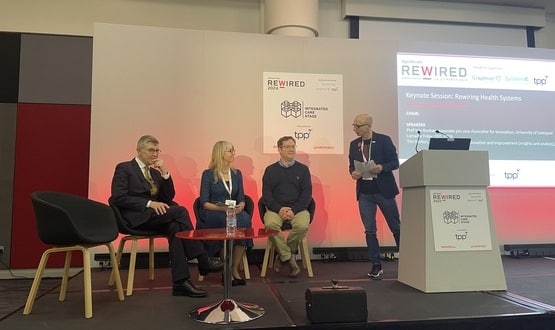Health tech adoption is tough and we aim to make it a little easier
- 7 September 2021

Lorna Green, director of enterprise and growth at Innovation Agency, which is part of the AHSN Network, discusses how technology innovation is offering new solutions to the challenges faced by the NHS.
The squeeze on healthcare systems has been a long-standing issue for medical professionals, with strains on staff and resources dating back long before the Covid-19 crisis. With an increasing proportion of the population living longer, innovation is critical to the development of a healthcare system fit for the growing challenges of the 21st Century.
However, implementing innovation in healthcare systems is difficult; they rely on trialled and trusted treatments, often developed over decades, to ensure no harm comes from medical intervention. Changing established practices takes persistence and patience, and crucially, trust and support from clinicians within the systems
Recognising this, the NHS has taken steps to make it simpler for health innovation to be adopted, namely, creating 15 Academic Health Science Networks (AHSNs). As the primary network of regional bodies that connect the NHS with academic organisations, local authorities, the third sector and industry, the AHSN Network is a catalyst creating the right conditions for change across the entire health and social care economies, with a clear focus on improving outcomes for patients.
A critical role in innovation
Following a successful clinical career in the NHS, I worked in a variety of MedTech businesses and a seed fund before joining the Innovation Agency shortly after it was launched in 2013. I am a champion of the transformational impact of innovation on healthcare systems and facilitate bringing the right parties together to deliver health innovation that drives positive patient outcomes.
The AHSNs are regional organisations that combine to offer the industry and the third sector a route into the NHS and social care. The NHS is a complicated organisation, where regional needs and national specialist services combine. Despite it being the largest employer in Europe and being responsible for the wellbeing of more than 60 million people, there are no centralised budgets and it is not a top down organisation. The AHSN Network was established in 2013 to help businesses and academia showcase innovation.
A longer journey
Traditionally businesses might consider clinical approval from regulatory body NICE as a critical milestone on the adoption journey. However, this is often just one step –critical though it is, NICE regulation does not mean instant mass adoption across the NHS. The process is more nuanced than this and involves NICE approval as a first step along a route to wider adoption across the country. But there are still further challenges to consider.
For example, innovators need to prove not only a clinical case but an economic and practical one; training busy staff in new procedures – including shifts across a 24-hour working period – and being patient in terms of adoption timescales, which can often take several years.
Innovation adoption – examples of good practice
Despite the need for this longer-term approach, there are examples where innovation has been fast tracked by the AHSN Network. One example from my own region is Inovus Medical – a multi award winning designer and manufacturer of surgical training technologies, based in St Helens.
The company has a clear purpose: to improve surgical care through connected training. The AHSN Network helped the company move to wider adoption across the NHS, supported the company in securing funding, and provided access to the right connections for showcasing the company’s innovation within the wider NHS.
One of the recent MedTech success stories is Sky Medical Technology’s geko™ device. This wearable, watch-sized, medical technology device attaches to the leg, using electricity to stimulate nerves and in-turn muscle contraction, creating blood flow equal to 60 per cent of walking without the wearer having to move. It is painless to wear and has been proven to reduce the incidence of blood clots for patients undergoing medical procedures in hospital.
I have worked with Sky Medical Technology to help extend the reach of the company beyond hospital. The interesting thing about Sky Medical Technology is that it is one device that can apply to multiple significant medical issues. Electrical stimulation of the leg to generate additional blood flow can not only help with reducing the risk of blood clots developing in a hospital environment but also help reduce swelling in pre- and post-operative patients.
Best practice in driving adoption
Facilitating risk and cost share between private corporations and health services can be difficult to implement but there is certainly movement in this direction. As more venture capital is attracted to life sciences, we are seeing new business models beginning to emerge. I am encouraged by the patience that venture capital money demonstrates in many cases. Where traditional technology entrepreneurs tend to look for a fast exit, life sciences specialists understand that the route to adoption may take longer but can also be more rewarding.
Overall, my advice to businesses looking to drive wider adoption within healthcare services is to be patient but persistent. Historically the NHS has sometimes found it difficult to articulate its requirements, but this has vastly improved over time. Innovation is being supported not only by the AHSN Network, but also by programmes the network supports, such as the NHS Innovation Accelerator which supports the uptake and spread of promising, impactful innovations. Furthermore, the NHS Accelerated Access Collaborative brings together industry, government, regulators, patients and the NHS to remove barriers and accelerate the introduction of ground-breaking new treatments and diagnostics that can transform care, while the Small Business Research Initiative (SBRI) enables the NHS to access innovations that solve unmet needs.
This growing ecosystem of support networks is helping innovation transform how healthcare systems operate by offering faster and simpler solutions to medical technology implementation.




